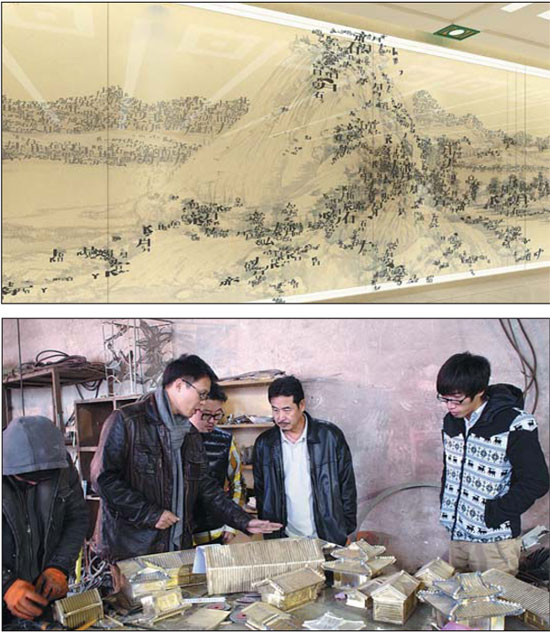Underground art, literally
2013-03-22 08:55:11

|
From top: Design sketch of the replica of Dwelling in the Fuchun Mountains for the National Art Museum of China Station. Wang Zhong (second from right) and his colleagues work on the subway project. Photos Provided to China Daily
|
For example, Line 8 along Beijing's central axis is called "mark of an ancient capital", while Line 10, passing Beijing's major business and recreation areas, is themed "colorful new life".
Wang says a lot of thought went into design for the National Art Museum of China Station. Team member Ma Juncheng came up with the idea of using character radicals to create a replica of Dwelling in the Fuchun Mountains, by Yuan Dynasty painter Huang Gongwang (1269-1354).
"Chinese characters have been passed on for thousands of years," Ma explains. "They represent our culture, which is also famed for its continuity."
Painters once drew frescos at stations along Line 2 in the 1980s to introduce the capital's history, but they generally mimic Soviet-style works in Moscow's subway.
"Those works are of a very high standard as single works, but many are easily overlooked because of poor lighting conditions," Wang explains. "You cannot expect passengers in a hurry to stare at these great works and admire this city's panoramic epic with just a glance."
A similar type of work has been unveiled on Line 6: a series of frescos to reflect Beijing's landscapes.
A 100-square-meter fresco at Beihai North Station portraying Beihai Park in Spring has attracted considerable media attention. It took one year for Sun Tao from the China Mural Association to use 50 kinds of stones from more than 10 countries to create the giant work.
Even so, Wang wants more diversity.
"Art has been used as supplemental decoration, but now it should make the whole space more dynamic."
Wang says he was impressed by the Crown Fountain in Chicago's Millennium Park, which shows ordinary people's faces on big LED screens when the fountains erupt.
In response, his team designed a work called Beijing Memory at the Line 8 station of Nanluoguxiang, which is well known for its hutong. A portrait of people's lives is made up of hundreds of glazed tiles, in which he plans to embed an article of daily use.
"It doesn't matter whether it is a teapot or a sewing machine component," Wang explains. "What matters is that it represents our collective memory. Taking the subway is not only traveling through space, but also through time."
Though it is common to see these old items in antique markets, he expects ordinary Beijingers to donate their own pieces.
"You can imagine how excited one might feel when one's belongings are displayed in public," Wang says excitedly.
Wang's team has many other ideas, like a painting of rippling waters that changes according to the angle. Some ideas, however, were vetoed because of safety concerns.
"The subway authorities would not allow us to install various electric cables or use some kinds of materials," says Wu Dingyu, the designer at Guloudajie Station. "And the space left for our creations is still limited."
However, Wu is glad artists now have more say in the design of the capital's subway.
Contact the writer at wangkaihao@chinadaily.com.cn.
